May 30, 2025 | 15:59 GMT +7
May 30, 2025 | 15:59 GMT +7
Hotline: 0913.378.918
May 30, 2025 | 15:59 GMT +7
Hotline: 0913.378.918
Arriving in Bai Tranh area in Van Phong Bay, Van Ninh District of Khanh Hoa Province, visitors can see a school of valuable original seed short-finned pompano raised by the Aquaculture Research Institute I.
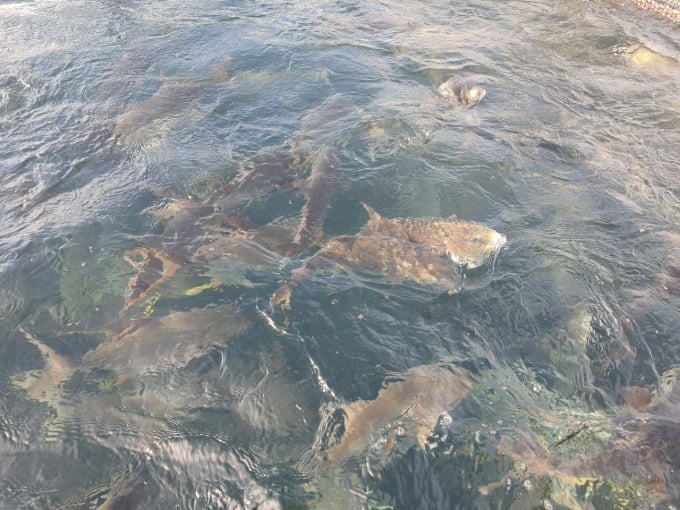
Yellowfin pompano, each weighing 4-6kg, have been raised by the Aquaculture Research Institute I. Photo: Kim So.
A total of 22 square Norwegian styled HDPE cages have been built to raise hundreds of yellowfin pompano with parents and breeding fish.
Chu Chi Thiet, Director of the North Central Aquaculture Research Sub-Institute (under Institute I), said that since 2018, the unit has been assigned by the Directorate of Fisheries to produce and supply yellowfin pompano.
Up to now, the unit is keeping 232 pairs of parents (464 children) of yellowfin pompano in Van Phong Bay.
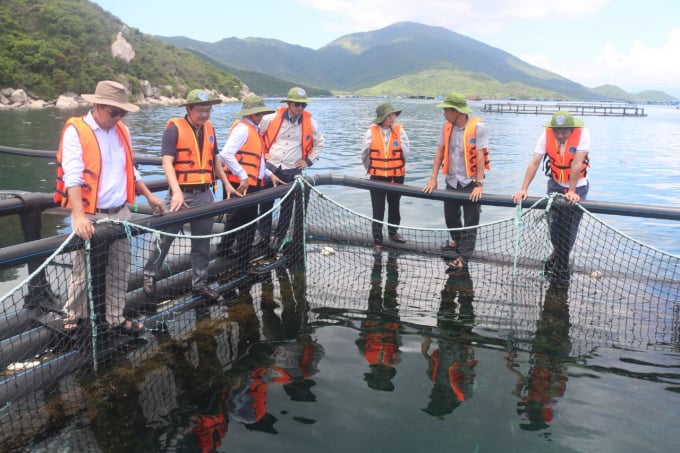
The parents fish are reared in HDPE square cages. Photo: Minh Hau.
Thiet said that to protect and take care of this original breed of yellowfin pompano, the unit arranges a force of two or three people to work all the time. The period from lunar December to May is the breeding season of fish, workers have to work harder, because they have to take care the fish that lay eggs and then, quickly transport the eggs to the hatchery on the shore.
“To know if the fish are about to lay eggs, we have to catch each fish and then use an egg probe (silicone tube, with the diameter of 1,000 µm) through the genital opening to get testing sample. If eggs are found, the fish will be placed in a separate cage, then injected with reproductive hormones. After 30 - 48 hours, the fish will lay eggs. Normally, fish spawn at night, so we collect the eggs and transfer them to the hatchery early the next morning,” said Thiet.
According to Thiet, the unit has mastered the stable production technology of yellowfin pompano with high technical criteria. Specifically, the rate of broodstock maturation reach more than 85 per cent; the percentage of broodstock participating in spawning more than 70 per cent; survival rate from fry to fingerlings (size 3 cm) more than 17 per cent and malformation rate less than three per cent.

Currently, the Institute of Aquaculture Research I is keeping 232 pairs of broodstock yellowfin pompano. Photo: Kim So.
Nguyen Thi Le Thuy, Deputy Director of the North Central Aquaculture Research Sub-Institute said that the reproductive capacity of female fish reached over 5,000 fry/kg .
Eggs after being collected are incubated in composite plastic tanks with a volume of 500 - 1,000 liters, incubation density of 500 eggs / liter.
After hatching 2-3 hours, the fry will be collected and transferred to the nursery tank.
The density of fry in rearing is from 40 to 60 fish/liter.During the period from 18 to 22 days, fry will be fed with plankton feed. After that, the fish will be brought to the cement tank (22 m3 / tank) in the farm to be raised for up to 2 months with industrial food.
When the fingerlings reach the size of 4-5cm, they will be sold or brought back to square or round HDPE cages on Van Phong Bay for further rearing or grow-out.
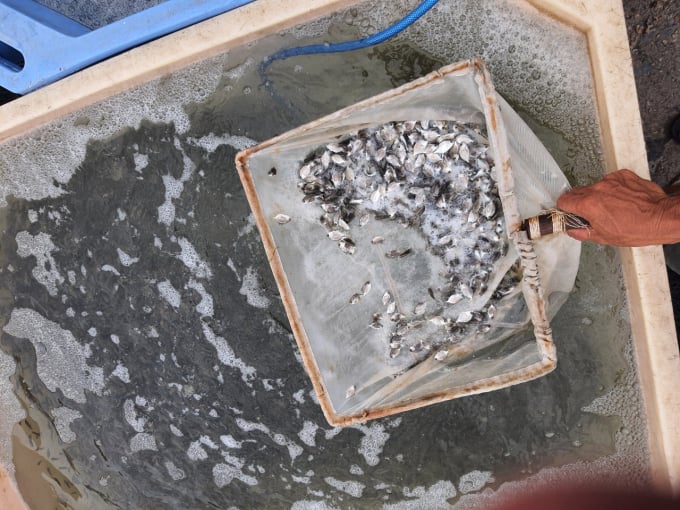
Yellowfin finfish are produced by the Research Institute of Aquaculture I. Photo: Minh Hau.
According to Thuy, the unit's production capacity is about 1 million breedings per year. In addition to meeting the needs of closed farming of Institute I, breeding fish is also provided to farmers in provinces such as Quang Ninh, Hai Phong, Khanh Hoa, Vung Tau, Kien Giang.Breeding yellowfin pompano on an industrial scaleYellowfin pompano belongs to the group of fierce, carnivorous fish, distributed in coastal waters with sandy bottoms, seaweed, sea grass, and coral reefs. They are marine fish with high economic value, fast growth rate, can reach commercial size 0.6 - 0.8 kg/fish after 8-10 months of feeding with industrial feed. Yellowfin pompano is less likely to get sick and can be kept at high densities in ponds or cages in brackish and salt water areas.
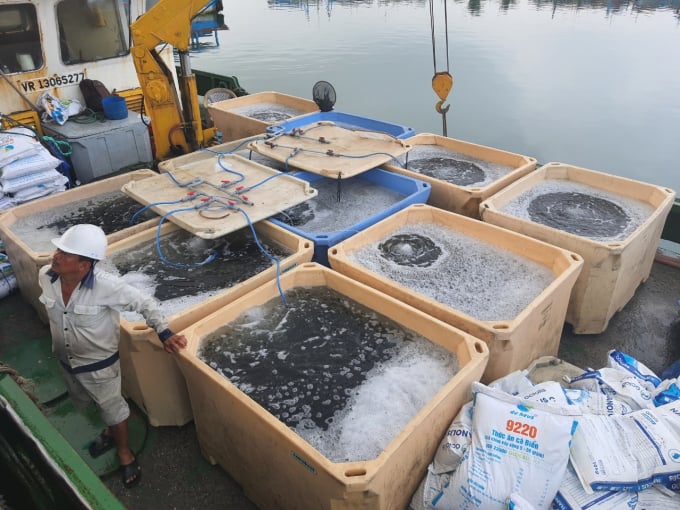
The produced fingerlings are transported to nursery on Van Phong Bay. Photo: Kim So.
At Institute I, for many years, commercial yellowfin pompano have been successfully raised in HDPE cages, with the survival rate usually reaching 76 - 84 per cent .
Pham Duc Phuong, Director of the Center for High-Tech Aquaculture (Institute I), said that after reaching the size of 2-3cm, the fingerlings will be transferred to the Centre's marine farm on Van Phong Bay for rearing. HDPE cage has a circumference of 60m, a net depth of 8m, a volume of 2,500 cubic metres.
This round cage can raise up to 100,000 fish, with a lower loss rate than rearing in the farm, because the rearing environment in the sea is open and clean, so the water is clean, ensuring the growth and development of the fish. After 40-45 days of rearing, fish will be screened and stocked for grow-out in HDPE round cages. According to the design, this cage can release up to 50,000 yellowfin pompano, with a yield of 25 tons/cage.
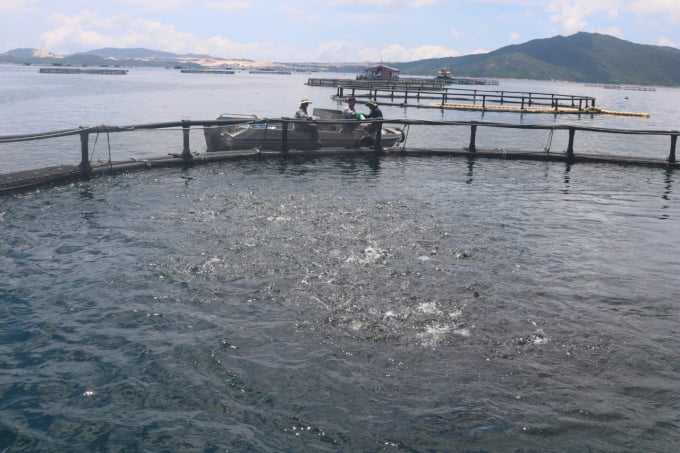
Fish are reared in HDPE round cages with low loss rate, before being sold or raised for commercial use. Photo: Kim So.
However, according to Phuong, currently the farm only releases about 25,000 fish/cage, with a harvest output of 23,000-24,000 heads, each weighing from 0.6-0.7kg, equivalent to 15-18 tons/cage.
From 2018 to now, the farm has operated stably with an output of about 200 tonnes/crop. Before the COVID-19 pandemic , about half of commercial fish production was consumed domestically, and was also exported to the US and Middle East countries with the selling price ranging from VND110 ,000 to 150,000 per kg and a profit of 20 - 30 per cent.
However, in the past two years, due to the impact of diseases and high transportation costs (containers), farmed fish are mainly consumed domestically.
Currently, the COVId-19 pandemic has been controlled, farms are promoting commercial stocking to serve consumers in the near future.

The Aquaculture Research Institute I is now successfully raising commercial yellowfin pompano on an industrial scale. Photo: Kim So.
It is known that this is the first industrial-scale marine fish farm (mainly yellowfin pompano) in the country to be recognised as meeting VietGAP standards. The farming process absolutely does not use antibiotics, uses industrial feed, the loss rate is low.In addition, Institute I has mastered the technology of designing and installing HDPE cages according to Norwegian technology with localised cage materials, reducing costs by more than 50 per cent compared to imported cages. The system of cages and anchors is designed to resist storms at level 11. However, in fact, it can still withstand a strong storm of level 12 and evel 15 (Damrey) that landed at the end of 2017 and passed through the cage area.
In October 2020, Deputy Minister of Agriculture and Rural Development Le Quoc Doanh visited the marine fish farm of Institute I and highly appreciated the unit's pioneering in raising marine fish with Norwegian-style cages. Institute I has not only mastered the technological process of producing yellowfin pompano and industrial feed according to the cooperation formula between Institute I and De Heus Company (Netherlands). It but also started commercial farming, biological safety, application of Norwegian-style cage technology suitable to actual practical conditions in Vietnam.
Translated by Hien Anh

(VAN) Several scientists and farmers are experimenting with soil treatment in some key durian-growing regions such as Cai Lay (Tien Giang), Dak Song, Gia Nghia, and Dak R’lap (Dak Nong).
/2025/05/25/4127-3-073637_820.jpg)
(VAN) Thanks to the promotion from an FAO-implemented project, vegetable production in greenhouses in Moc Chau has seen strong development, from 1.5 hectares in 2021 to nearly 50 hectares in 2024.

(VAN) FAO has recently supported USD 140,000 to implement the project 'Risk mitigation human-animal interface risks through disease control initiatives in pig farming.'

(VAN) The People's Committee of Tra Vinh province has approved an adjustment to the investment policy for the Green Hydrogen Plant project, increasing its area to approximately 52.76 hectares.
![Reducing emissions from rice fields: [2] Farmers’ commitment to the soil](https://t.ex-cdn.com/nongnghiepmoitruong.vn/608w/files/news/2025/05/05/dsc08881jpg-nongnghiep-140632.jpg)
(VAN) Clean rice cultivation model in Thuong Tan commune, Bac Tan Uyen district, is assisting local residents in achieving sustainable agriculture by substantially reducing costs, increasing productivity, and protecting the environment.

(VAN) At the conference to disseminate Resolution No. 68, AgriS introduced its digital agricultural ecosystem and reaffirmed its commitment to accompanying the Government in promoting private sector development and sustainable agriculture.

(VAN) 'Blue Ocean - Blue Foods' initiative is designed to restore marine ecosystems and establish sustainable livelihoods for local communities by cultivating a minimum of 1,000 hectares of cottonii seaweed in the first three years.